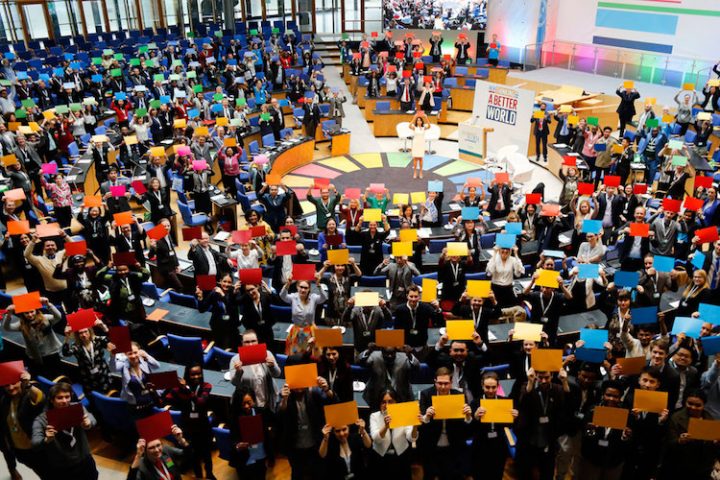By Rita Joshi
BERLIN | BONN (IDN) – Inspired by innovative and forward-looking concepts, the Global Festival of Ideas for Sustainable Development, the first in a series of annual forums to help achieve the United Nations-led Sustainable Development Goals (SDGs) wrapped up in the German city of Bonn after intensive debates and ‘game playing’ on March 3.
The UN conference aiming to chart a new way of thinking on addressing some of the world’s most complex development challenges was hosted by the UN SDG Action Campaign in partnership with the Overseas Development Institute (ODI) with the support of the German Government. It was the world body’s first ever ‘playable’ policy conference.
“We have to make the world aware of this […] agenda that is definitely going to transform the planet and that is going to ensure that no one is left behind,” Cristina Gallach, the UN Under-Secretary-General for Communications and Public Information, told the Festival.
“The more we communicate about the SDGs and make people aware of the agenda, the more the governments will be accountable and will ensure that it is implemented,” she added.
The UN Department headed by Gallach, Department of Public Information, is the organization’s entity tasked with informing the wider world on the SDGs and ensuring that the 17 goals are known and understood.
To that end, 17 ‘icons’ – each with a designated bright colour, short name phrase and single image – have been created to illustrate each Global Goal.
The icons have also been translated in over 50 languages, from Czech to Bahasa Indonesia, and the number is growing.
‘Going local’ is important to allow people around the globe take ownership of their development agenda, said the senior UN official. “There are a lot of communications that need to be done locally in the different languages people speak locally on a daily basis” she explained.
Going local also helps people on the ground feel that that work is being done, “so local governments have to implement and local media have to monitor what goes on,” added Gallach.
Focus on youth
The UN has also placed a particular focus on youth with regards to the SDGs and considers a key partner in the achievement of the Goals.
“[The youth] are aware the planet is not going well and they might inherit something really bad so they want to be part of the transformation”, said Gallach, adding: “They know the goals will be achieved when they are adults, when they will be at the peak of their lives.” (Read IDN interview with Gallach.)
The senior UN official also underscored the importance of forging partnerships in the achievement of the SDGs, as well as in communicating them.
In addition to the SDG icons – designed in partnership with Jakob Trollbäck, working with Project Everyone – other examples include the branding of the Mexico city metro and a rap song about the Goals in collaboration with Flocabulary, which uses educational hip-hop music to engage with students.
“The more we communicate the more we will harvest for partnerships [and] this agenda cannot be implements without very strong partnerships” stressed Gallach.
Among the technology experts, gamers and activists putting their heads together to figure out how best to help countries implement the UN vision of a more just and equitable world where no one is left behind, was Ryan Hooks, manager of a software company called Huxley, who showed off his ‘hands-free gardening” app.
According to UN News, to demonstrate the app’s capabilities, Hook pointed his phone at a plant on the table and his app identified it as “apple mint”.
“It’s augmented reality, it knows what kind of plant it is, what percentage its health is, when to pick it, pack it, ship it and the environment (around it), so people can have hands-free augmented gardening,” he explained.
The hands-free gardening app, Hooks continued, makes it more efficient to use hydroponics, a method of growing plants without soil, which also uses 95 per cent less water to grow plants.
“It’s an AI (Artificial Intelligence) and augmented reality for plants. Greenhouses that use hydroponics to circulate the water are very complex systems and it’s hard to scale water efficient food solutions. I’ve found that augmented reality and AI can be really useful for reducing labour cost,” he told UN News.
Participants at the Festival were also engrossed in the 2030 Hive Mind game, where they played for a hypothetical country, planning policies, and convincing other players to join forces with them.
The Festival organizers say that the game, which focuses on the SDGs and the 2030 Agenda, reveals the tough choices and trade-offs that might have to be made along the road to sustainable development for all over the next 13 years.
Tom Juntunen, of the U Begin company, was playing for Goal 9, which focusses on building resilient infrastructure, promoting inclusive and sustainable industrialization and foster innovation.
When Juntunen is not at his booth in the exhibit, he walked around the conference centre trying to convince other players to support his policies.
“There’s a lot of negotiations, it’s a very robust simulation of real life dynamics with policy negotiation. Everyone has what’s important to them and what’s not important. In playing the game, you experience the parallel of that in a virtual environment. It is challenging as it is in real life,” he said of Hive Mind 2030. [IDN-InDepthNews – 04 March 2017]
Photo: Delegates attending the Global Festival of Ideas for Sustainable Development form the SDG wheel at the World Conference Center (WCC) in Bonn, Germany. Credit: photothek/Ina Fassbender
IDN is flagship agency of the International Press Syndicate.










